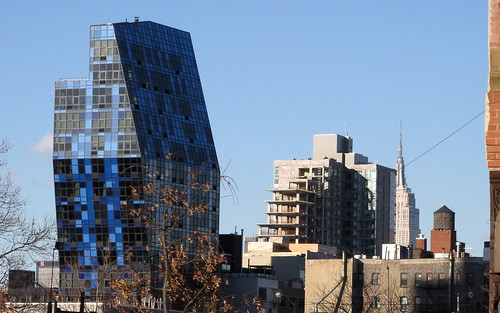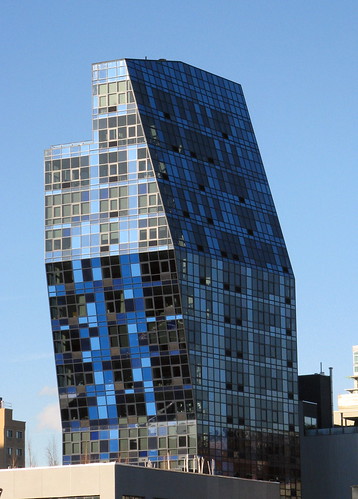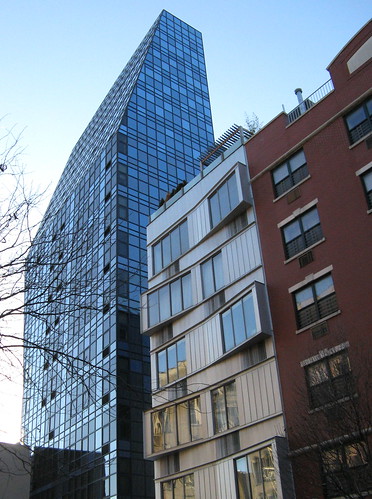Sometimes a building just says “look at me” before you know it and your eyes are captivated in curiosity and wonder. It was an icy cold January afternoon with a brisk breeze, on a walk south of Grand Street in Manhattan’s Lower East Side. The brick storefronts of the 19th century tenement buildings beckoned warmly, with their delis, cafes, boutiques, offices, and taverns. Then suddenly in the distance the Blue Condominium appeared, above most of the rest and flanked by a bright afternoon blue sky, as if the two were appearing in tandem.
In a city where huge, nondescript gray or black metal-and-glass high-rise boxes are replacing the crafted 19th and 20th century buildings that have so much character, the Blue residential tower at 105 Norfolk St. feels like a gift. It is interesting, playful, and mostly graceful. From a distance as one walks on different streets and rounds various corners toward it, the building offers a constant interplay of angles with its neighbors and the sky. It can appear sleek and beautiful from one view, and bulky and garish from another. One can see differing patterns in its pixelated façade of spandrel (covering) glass in four shades of blue. New York Times architecture critic Nicolai Ouroussoff wrote that the building of angular forms and blue panels “has a hypnotic appeal.” Finding that my eyes kept looking toward it, I agree.
The Blue Condominium, from a distance
The Blue building viewed from the south
Buildings evoke strong moods and emotions, and the qualities can change from day to day and season to season. The bold blue, in all its variation, felt cheering and light-hearted for a cold winter day with the mounds of snow and some ice in the Lower East Side – a little Miami break. During the hot months, its blue could feel dazzling and refreshing when the New York streets are steamy and oppressive.
Blue the condo, as I affectionately call it, also has little of the pretension of so many luxury residential high-rises in New York these days, and seeks in its own way to embody the neighborhood’s spirit. When I arrived in front of it, I found no swanky sign that announced its “luxury” status nor is there an over-the-top screaming “I’m-chic” lobby like the places that take themselves too seriously. This appears to be exactly what architect Bernard Tschumi and developers Angelo Cosentini and John Carson intended for the 16-story condo building of 32 apartments, constructed from 2004-2007.
Fit Or Misfit?
Tschumi sought to design a distinctive architectural form that would reflect the neighborhood’s mosaic: its diverse population; its reinvention over generations as everything from a center of Jewish culture to a hub of Chinese businesses; and its waves of ethnic immigrants – Italians, Ukrainians, Poles, Chinese, Bangladeshis, etc. – and artists who have made the Lower East Side their home. It seems to say, “You can be different here and you will not be judged.”
The architect had to contend with the challenges of a tight parcel; the city’s zoning rules; and the need to squeeze the maximum space out as a commercial venture, and he wanted a design that differentiated the building from other residential high-rises. The result is a building that angles and tapers in and out in unusual and eye-catching ways. Its base cantilevers over a lower commercial space to the south. Many units have sloped window walls. Blue matches other international projects that Tschumi, former Dean of Architecture at Columbia University from 1988-2003, has designed – 21st century buildings where the materials have dynamic flow, energy, and sculpted form without creating mayhem.
Those who love New York’s treasure of Art Deco, Gothic and Greek Revival buildings; its brownstones; and its solid brick structures with terra cotta decoration may not love the Blue building. And those who lament the loss of the Lower East Side’s edginess have been lamenting it as well. They see it as another invader for the well-heeled at a time when the neighborhood is gentrifying – and the changes and losses are undeniable.
Still, reasons exist to embrace it. For one, the Blue building shows the ways we are building smarter. Tschumi aimed to design an “architecturally significant” structure with “the simplest $55 a square foot curtain wall,” he said in an interview with Architectural Record. It has sustainable materials such as bamboo floors and wall panels. It recycles space at the top of a neighboring commercial structure as an urban garden.
Moreover, while the march of luxury high-rises in New York continues apace, this is not just another gray box that ignores the context of its neighborhood. It brings to mind a colorful building of another era that sparked some strong criticism: Raymond Hood’s old McGraw-Hill building on West 42nd Street, constructed in 1930-31. The greenish-blue skyscraper with bands of glazed blue-green terra cotta brick stuck out in the neighborhood, though the publisher who built it hoped it would encourage others to follow McGraw-Hill into the area. Lewis Mumford called it a “stunt,” and the skyscraper drew scorn at the time among the architectural press. Today, it’s a landmark and a cherished vestige of a time when publishers had their printing presses right in Manhattan.
Sure, the Blue Condominium certainly can shock the eyes but its bold hue personifies a connection with the colorful character of the Lower East Side and to its remaking with each generation. The blue could be that found in the colorful pottery of the Europeans who emigrated and settled here, or it can be the blue hair color of a hip young woman hanging out at a late-night club. This isn’t, it says, a staid neighborhood. It will be fascinating to see if the Blue building influences the designs of future buildings in the Lower East Side.
The Blue building, 105 Norfolk St., on New York’s Lower East Side
View the slide show larger in Flickr.






I have been surfing online more than three hours nowadays, but I by no means discovered any attention-grabbing article like yours.
It’s a beautiful price enough for me. Personally, if all site owners and bloggers made just the right content as you did, the Internet might be a lot more useful than ever before.
Thank you very much for your gracious comments. I appreciate that very much, and I hope to live up to it.
Gratefully,
Susan